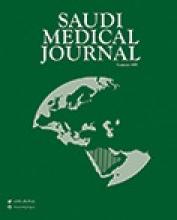Abstract
OBJECTIVE: To assess the prevalence of human T-cell lymphotropic virus type I and type II antibodies in blood donors donating blood for various reasons in a University hospital and to compare the results with other reports from the Kingdom of Saudi Arabia (KSA), and elsewhere.
METHODS: A 7-year retrospective review of blood bank records for results of serological tests at the King Fahd Hospital of the University, Al-Khobar, KSA, from January 1995 to December 2001 was conducted. The study included review of blood donor questionnaire cards as well as extraction of any other relevant information.
RESULTS: The results showed that the total number of blood donor units drawn during the 7- year period was 23493 units. A total of 50 units were found repeatedly reactive by enzyme immunoassay screening test (0.2%). Only 12 (0.05%) were confirmed reactive by western blot test and 4 were found to be indeterminate. Nine (0.04%) of the confirmed samples were from Saudi nationals. All 3 non-Saudi confirmed reactive donors were Indian nationals, while the 4 indeterminate cases, 2 were Saudis and 2 were Egyptians. A statistical estimate of the maximal risk of finding a positive donor in this donor population subgroup is in the order of 0.05%. The number of Saudi blood donors during this study was 16434 (80.3%) and non-Saudi donors was 4027 (19.7%).
CONCLUSION: Based on these results it is shown that the prevalence of this virus is still low among blood donors in the Eastern region of Kingdom of Saudi Arabia.
- Copyright: © Saudi Medical Journal
This is an open-access article distributed under the terms of the Creative Commons Attribution-Noncommercial-Share Alike 3.0 Unported, which permits unrestricted use, distribution, and reproduction in any medium, provided the original work is properly cited.






